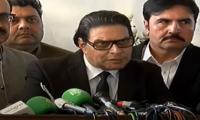The MQM and its chief Altaf Hussain are facing two serious charges — one related to party’s militant, the other to links with RAW. Though different in nature, the PPP had faced similar situation from 1979 to 1988. How its leader, the late Benazir Bhutto, tackled militancy in the party may provide few options for today's civil and military leadership. She once shared many facts with this scribe. Ironically, she and her brother Mir Murtaza Bhutto fell victim to terrorism.
MQM's alleged militancy requires a different study. Many PPP leaders and workers, once charged for links with militancy and RAW, later joined mainstream politics and some of them got good positions, both in the party and the government.
In contrast, MQM faces a dilemma today. In a recent meeting between Rangers DG Maj-Gen Bilal Akbar and MQM leaders, the party was offered "assistance" in case they abandoned its alleged militant wings. The offer included rehabilitation of those involved in street crimes and extortion. Those facing serious charges should face the trial while a Judicial Commission can also be formed on other charges.
MQM's alleged militancy has different dimensions, but in the last 30 years it had been dealt with either through successive operations by military, police and rangers or through "proxy." The party leadership itself failed in addressing this issue while the establishment used it against political opponents.
The late Benazir Bhutto brought in the mainstream hundreds of party workers accused in the 80s of working for terrorist group — Al-Zulfiqar Organisation (AZO) — getting training in India and Kabul with the RAW and the KGB.
AZO, was allegedly formed by former prime minister Zulfiqar Ali Bhutto’s two sons — Mir Murtaza Bhutto and Shahnawaz — to take revenge from Gen Zia and those who had a role in his execution.
Gen. Zia used this issue to crush PPP and prolong his rule until he himself was killed in a mysterious plane crash on August 17, 1988.
When Benazir Bhutto, decided to return to Pakistan, in 1986, she was well aware of the AZO factor. So before coming to Pakistan, she went to Syria, and met Murtaza, persuading him to shun his armed struggle and joine democratic struggle of MRD. It took five years before Mir realized and announced his plan to join mainstream politics and abandoned armed struggle in 1993.
Former president of PPP’s Karachi Division, Masroor Ahsan, recalled his meeting with Benazir, when she asked him to either stay in the PPP or with Mir. Same message was for PPP’s all alleged militants.
"I never supported armed struggle as Bhutto sahib once told me in the death cell that he himself had turned down plans to get him released through militant means. So I was against Murtaza's style of politics and wanted all to abandon it," he added, saying, “she always believed that democracy is the best revenge. But, a PPP group led by Ali Sunara left the PPP and remained loyal to Murtaza till his assassination. In Karachi, many of these alleged militants later become part of Lyari gang war. They either left the country or were killed."
Former ISI chief, the late Lt Gen Hameed Gul (retd) once told this correspondent in a TV interview that how he misunderstood Benazir.
"To be very honest I thought if she wins the elections she would implement Article 6 of the Constitution for the 1977 military coup and follow the policy of revenge. The purpose of forming Islamic Jamhouri Ittehad (IJI) was to prevent her from getting two-thirds majority," he said.
“When I first met her after PPP won the elections and gave her briefing on national security issues I found a real nationalist and patriot in her. She was concerned about Pakistan and never gave an impression of invoking Article 6," he added.
“The establishment has its own way and when it got angry with Benazir, it used MQM, first in vote of confidence against her in 1989, when she was the Prime Minister, and then a law and order situation was created which led to her sacking in 1990."
The late chief minister Jam Sadiq Ali, once accused of having links with RAW, was assigned the task of teaching the PPP a lesson. All cases of AZO, were reopened and many PPP workers, MNAs and MPAs, who had joined mainstream politics were once again put behind bars.
As a result of Jam's action many of those PPP workers who had shunned militancy rejoined Murtaza wasting Benazir’s efforts.
In her second tenure while she continued to follow this policy for those PPP workers who were ready to give up militancy, she once gave similar advise to the then leadership of MQM after 1992 military operation. Had she announced public amnesty for all "militant wings" things might have improved, but, on the contrary, she went for a major Karachi operation in which many alleged MQM militants were killed in extrajudicial actions.
In 2002, former president Gen Pervez Musharraf (retd) tried to put an end to "proxy" practice of handling militancy in Karachi.
He empowered local governments and reached an unannounced agreement with MQM leadership. It got powerful KMC, a governor with administrative power and 50 per cent share in the government. What he did not do or check was MQM’s alleged militant factor.
In the end, his establishment used MQM’s militancy against former chief justice Iftikhar Chaudhry on May 12, 2007. Six years later in 2014, an attempt was made and MQM was asked to shut down Karachi for one or two days during Imran Khan's dharna, but deal did not work out.
Thus, there is a way to end militancy, which is certainly not through "proxy." The late Benazir tried to end it in her own party at least till she herself became victim of terrorism on December 27, 2007. But, a will is required from all sides. Is there any such will today?
The writer is the senior columnist and analyst of GEO, The News and Jang.
Video putatively shows that Bushra shifted from her vehicle to Gandapur’s placing her bag first and later herself
ECC directs Finance Division to furnish detailed report on Pension Scheme Amendment
Vawda says woman said she would march on D-Chowk but later ran away, while referring to Bushra Bibi
Establishment Division has issued official notifications of these postings and transfers
Minister says police was effectively held hostage by KP CM and Bushra Bibi during recent PTI’s protest
Maryam says she was really sorry for inconvenience suffered by people







